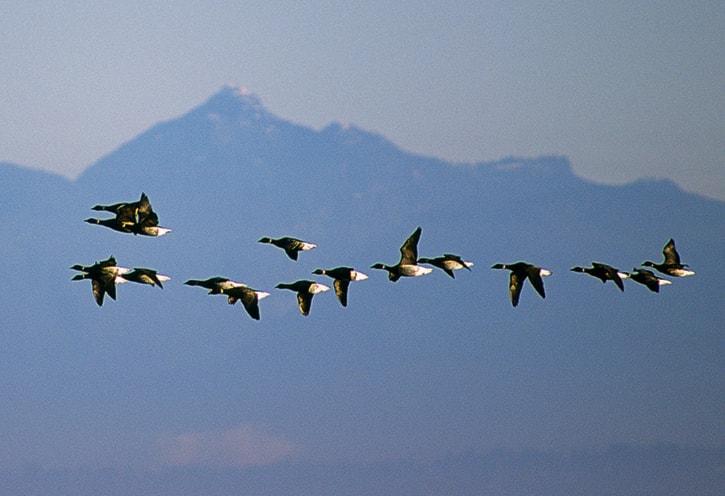Beach Grove in South Delta was named ttunuxun, or “place of ducks” by the Coast Salish.
This corner of Boundary Bay has shallow waters, submerged eelgrass meadows and a gently-sloping, gravel shore.
In the late 1800s, vast numbers of ducks, cranes, geese and swans were killed here in unregulated hunting for the Christmas market.
The location remained a hot spot for sportsmen into the 20th century, with Black Brant, a small sea goose, being particularly favoured.
Hunting shacks lined the Beach Grove shoreline until it became a regional park in the 1980s.
Despite constant recreational use, this area remains a highly attractive habitat for ducks and geese, including Brant.
Several thousand Brant visit the Fraser estuary annually and many stay the winter.
In the White Rock area, they are most easily seen out on the water in Semiahmoo Bay, or over the border in Drayton Harbor.
The majority of Brant seen in local waters belong to the Pacific Black Brant subspecies, nesting in coastal Alaska and the Yukon, and wintering south along the Pacific coast to Mexico.
A few paler, grey-bellied birds, known as High Arctic Brant, from islands in Canada’s far north, also winter here.
Brant numbers swell along the coast in March, during spring migration, and Parksville and Qualicum Beach on Vancouver Island hold an annual festival in celebration.
Brant face many lifetime hazards, both on the breeding grounds and during migration. They pair for life, and females particularly suffer hardship if their mates are killed.
Winter habitat to rest and feed without disturbance is important for these geese.
If you are walking a dog, remember to keep it on a leash when these and other birds are close to shore.
With so many waterfowl on Boundary Bay in winter, it may be difficult to distinguish Brant, which are only slightly larger than ducks. When they fly, the contrast between the Brant’s dark body and distinctive white tail makes it easier to spot.
A close view shows the small white collar on its black neck. Unlike its larger cousin, the Canada Goose, the Pacific Black Brant is a strictly salt water species, only coming to shore at low tide to graze on eelgrass.
It murmurs, rather than honks, and avoids flying over land, staying low over the ocean in long line or U formations.
Birdwatchers were out again last month counting Brant and other birds in the annual Christmas Bird Count, as local areas often have the highest number of species in Canada.
Anne Murray, the author of two nature books available in local book stores, writes monthly in the Peace Arch News – www.natureguidesbc.com
